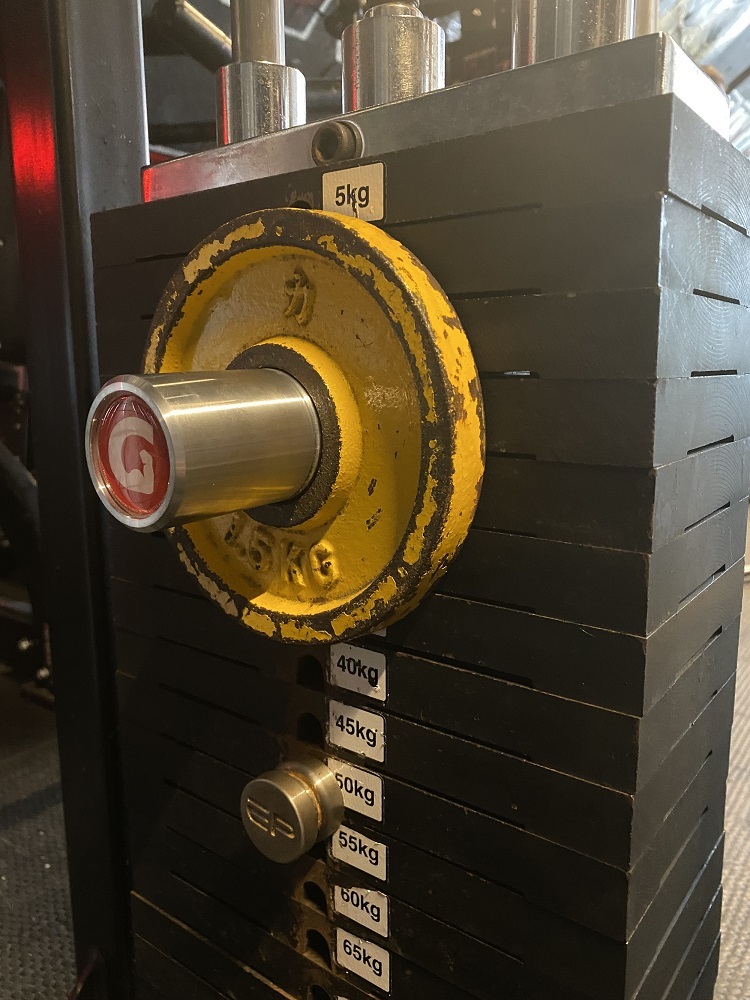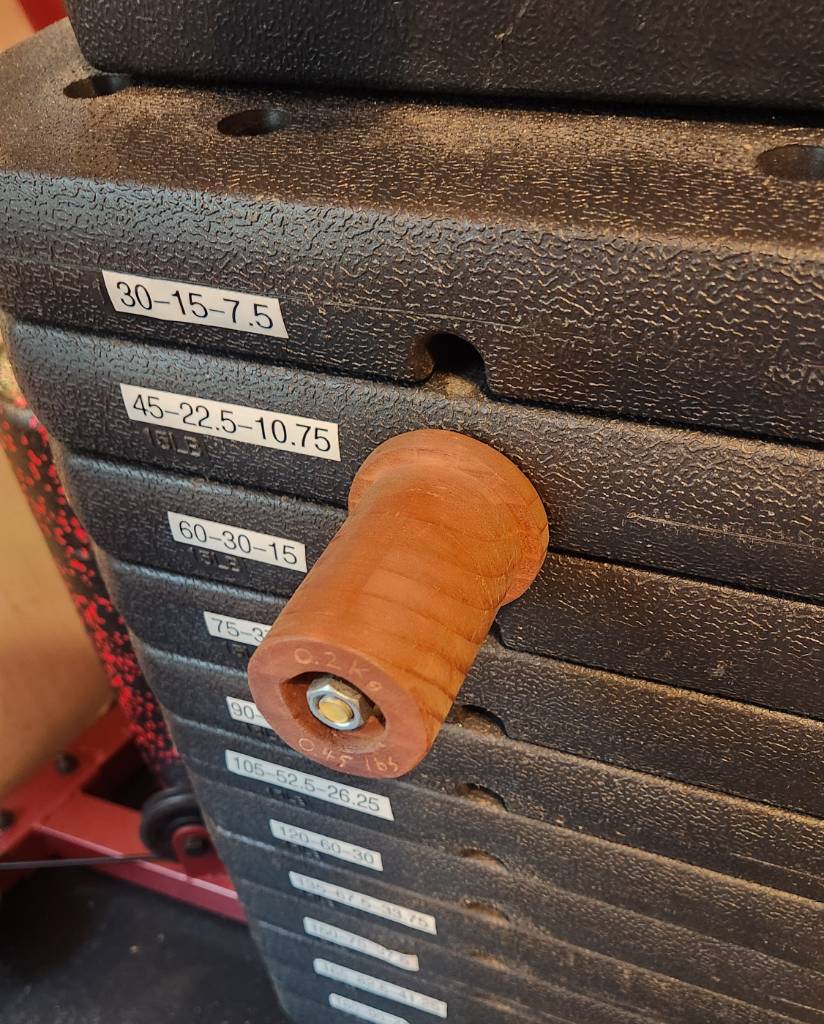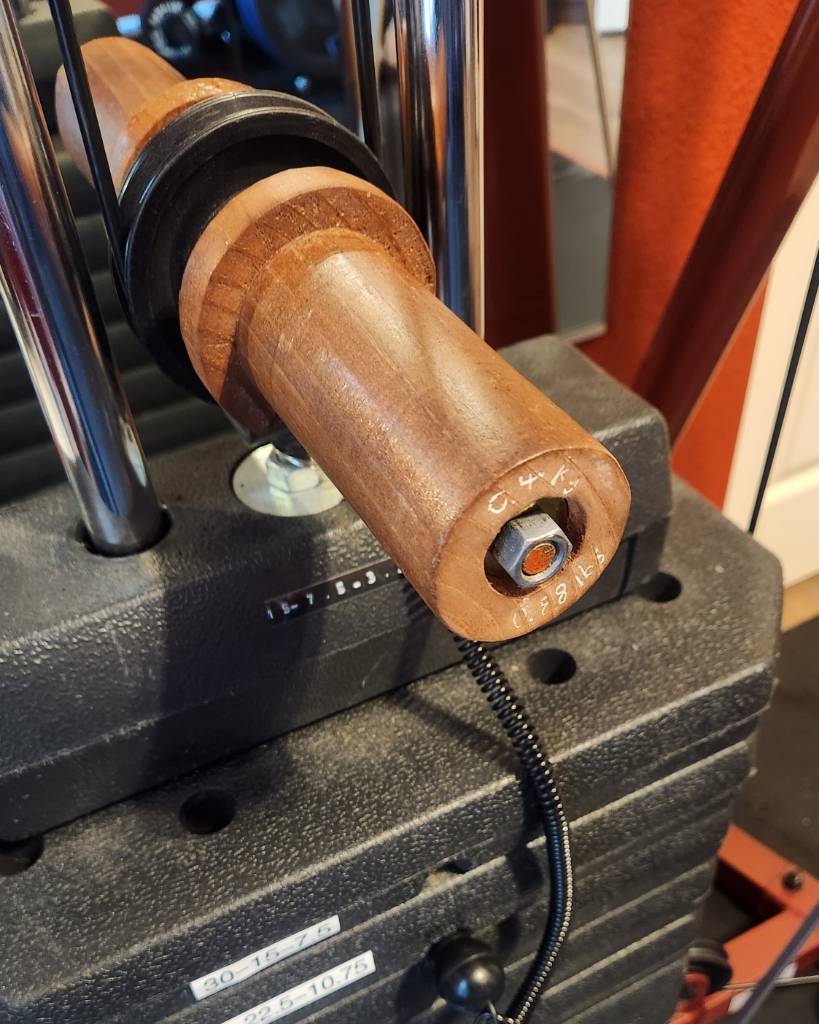I started lifting weights (again) and accurately tracking my progress (I bought a “cheap” workout and weight loss plan, which requires a lot of data so you can see your progress (or regress)). When bench pressing and doing squats on the (Cybex) Smith Machine I had assumed that the bar weighed 45 pounds like a free bar does and added it to the total weight. It wasn’t until my most recent session (finished about 30 minutes ago) that I realized that the bar doesn’t in fact weigh 45 pounds…but weighs anywhere from 7 to 30 pounds, according to what I saw from a quick search. I should have realized that it wasn’t 45 pounds because it felt pretty light. Google says that the average weight tends to be about 15 pounds, but I have no idea.
I was also using the (Cybex) overhead should press machine and saw that the plates past 50 pounds went in 15 pound increments. Then I noticed the additional weight at the top, disabled by a pin. When I lowered it down on to the stack there was no number on it. Was it 5 pounds? 7.5 pounds? 10 pounds? Who knows?
How are people supposed to know how much weight they’re lifting if things aren’t numbered properly? They have these huge stickers that say everything, but they can’t put “bar weighs 15 lbs” on it?
Step on a scale holding whatever you want to weigh.
Put down the thing
Step on a scale not holding the thing you want to weigh.
Subtract the second number from the first.
I realized I didn’t need a special scale to weigh light things if I just did it like that.
Now lift it up 11 more times. You’ve done a set… do it four more times, move on to the next object.
(I think OP is more talking about thinks you can’t bring to a scale)
This is a great method if you own the object in question… Sounds like OP is curious about equipment at their local public gym though.
I was under the impression most gyms had a scale, but I have a sample size of one gym that I’ve ever been to, and that gym had a scale.
Maybe that’s not as common as I imagined it was.
My gym has a scale, but not a digital one and it would be… Unusual, if not somewhat dangerous, to bring a bar across the entire place to where it’s placed.
I can see reasons why they wouldn’t want to do that, even if there is a scale.
Unusual? Sure.
Dangerous? Are you planning to carry it perpendicular to your body? That’s like how a car is dangerous if you drive it on the sidewalk.
Depends on your gym layout I guess. I’ve done this a few times when the bar weight felt off at a new gym. Do what you need to do. Don’t let the fear of weird looks deter you.
Or, just put the thing on the scale?
Many scales won’t register low weights, that’s what this method is for.
Or for something less wieldy like a large rucksack or a weights bar, you can be sure that you’re getting the accurate weight by holding it and putting your two feet on the scale correctly instead of trying to manipulate the object itself.
OP is looking for the weight of the bar on a smith machine, which means they’ll have to take the scale with them to the machine. That’s definitely not going to fly in most gyms. Nor would it work on the weights on a machine’s weight stack.
If you’re planning on using the same machine continually, you could instead track your progress rather than specific weights. Knowing that last time you lifted 3x weight and this time it’s 4x weight, you can still tell that you’re getting stronger.
Using the same bar every time, it’s the same weight, you don’t need to know what’s on it. Olympic bars (and most bars) are 45, so I just use that. It doesn’t on the smith machine because there’s a counter weight on it (to stabilize it)
But let me give you another idea. WHO CARES? Yeah I know we all like to track progress when weight lifting, but at the end of the day did you lift the weight and bring it back down? Did you do it multiple times? Did you do it to exhaustion? Great, you’ll grow. If you truly care then ask "When I used that same machine could I do it with more weight? Could I do more reps with the same weight? The machine itself doesn’t change so just use that specific type of machine as the metric.
I’ve found weight machines are NOT comparable to Free Weights, Which are not comparable to even smith Machines… So ultimately… Compare apples to apples.
Another example? I would consider a Chest fly to a chest fly from a different manufacturer… THOUGH I’ve seen a few times when this is just bullshit. I also think Calf raise machines are just phony weight at times. (Though remember when doing Calf raises, and Calf Raises sitting, your entire body weight is now missing) … Which can be true for many machines…
So ultimately compare apples to apples… AKA compare a machine (or a machine type) to that same machine type, and try not to confuse “Free weights” with “machine weights” because there is a correlation but it’s not worth figuring out.
Some people do need to track it and it has its own benefits like changing diet,sleep etc. according to it.
True, but as @Klinglink said, unless you are competing, you only really need to know trends. So knowing you lifted 100kg isn’t as important as knowing you lifted 10kg more (or less) than last week.
I’ve definitely noticed that there isn’t a correlation between free weights and the machines. Doing an Overhead Dumbbell Shoulder Press I was struggling at 20 pounds after about 9 reps, but with the Shoulder Press machine I had no problem doing 50 pounds.
A big part is always going to be stabilization, when you’re using the machines you don’t need to focus on those muscles, so I usually recommend people doing free weights. It’s a similar story to doing chest flies. But the big benefit of the machines is they’re designed to conform to the “optimal” range of motion, and somewhat less chance of injury
Yeah, I switched after one arm gave out with the barbells and I tweaked a muscle in my neck.
Why do you need to know? Just track the weights you put on, ignore the bar/machine
I do just this lol, (Bar+30kg)(1x8)
Use the “too heavy” method. If it’s too heavy for you try another one
I was also using the (Cybex) overhead should press machine and saw that the plates past 50 pounds went in 15 pound increments. Then I noticed the additional weight at the top, disabled by a pin. When I lowered it down on to the stack there was no number on it. Was it 5 pounds? 7.5 pounds? 10 pounds? Who knows?
A trick for these machines if you want to add weight in smaller increments and also know the weight you’re adding is to place a small plate on the pin (On the yellow pin in the image below). It would look something like the second image below. You can do that instead of using the unlabelled weight on the stack.


And as many others have already said, the actual number doesn’t matter much. If you go from one machine to another, even if it’s the same brand and same model, the same weight is going to give different resistances. The part that matters is that you progress. You know that if you add weight on the smith machine, then you’re moving more weight and you’re progressing. If you enable the small weight on the shoulder press machine’s weight stack, then it’s more weight than not having it enabled, but less than moving the pin down the stack.
Thanks! I’ve seen people do that, and I did it as well on the Lat Press machine but couldn’t do it with the Shoulder Press machine since the stack is enclosed in a shroud 😑
I figured progress at any rate is what really matters.
For people that are interested in the plate-bearing pin, you might find that they’re kinda expensive. However, it is something which can be constructed fairly simply, using wood and a threaded rod plus hardware. Fractional plates would usually top out at 5 kg or 15 lbs, so it doesn’t need to be made out of billeted titanium or whatever.

This is one such wooden pin I made, using a scrap 4x4 block of wood and a router. If for your homegym equipment, you may be able to permanently mount a peg for plates, which I’ve done for my functional trainer.

Thanks, but I live in an apartment complex so I don’t have access to any tools or space to do it in haha
On the Smith machine > track only the weights you add to it
On the other machine > It’s either 2 x 5 lbs or a single 7.5lbs, so you have a middle step/two steps before going up another 15lbs with the “regular” weights at the bottom
Thanks!
Unrelated but what kind of ‘plan’ did you buy, you don’t need anything, I have lost all the weight I wanted and didn’t pay a single dime for anything other than gym fees and a protein shake I bought only once when my cut got a bit more aggressive
As for progression, just make a list of exercises with sets and reps on your notes app and then update it every-time you hit the same lift again
If you want one to follow then its fine, but a lot from what I can tell is garbage, the only way to lose fat is a caloric deficit, if you realize that and how to track your macros you will have a much better time
It’s Built With Science, everything is laid out for you. It takes all the guesswork out of what you should be doing. I’m a computer geek, physical fitness isn’t my area of interest, so it’s nice to have someone be like “Here’s the two sets of exercises that you should be alternating between for the next 3 months, and then switch to these exercises. Track your progress or regress in this spreadsheet we made for you. Proper form and explanation are provided in YouTube videos and Slide sets. Also there’s a spreadsheet to help you Cut and then Bulk.”
It was like $120, and there’s a lot of content.
If you are not interested in weight lifting then ig it can get a little too much
Still Have atleast some fun though!
First, I am sorry for everyone just dismissing this question. There are many valid reasons for wanting to know the unloaded weight of machines, including just being curious. If you want to change up your routine or compare results between machines, you absolutely want this info.
Some machines will have this information in fine print on the main instruction panel or some small label on the machine. You have to search for it.
The most reliable way to know would be to ask the staff at your gym. A gym-employed trainer would be a great resource if they are off without a client. At my gym, I just put in a request that they label all of the machines with this info. It seems like a big quality of life increase for the cost of some printer paper and packing tape.
Keep lifting heavy and pushing for the details you want. I know on my leg press sled, I absolutely want credit for the 105 lb. sled in addition to the plates I put on it.
Curiosity would be the only valid reason for knowing. You can’t compare between machines, even if they’re the same model.
I would mildly disagree. Knowing your numbers for a lift can help you estimate where you should be on related lifts. It can also help you very roughly gauge your progress compared to others. The mechanical advantage, friction, and other physical aspects of any given machine play a huge role for sure, but one can broadly make comparisons.
where you should be on related lifts
What does that mean? You are where you are. Where you should be is where you end up when you do your best. Knowing the absolute resistance on a machine doesn’t help with that.
gauge your progress compared to others
If you mean comparing to other people, I strongly recommend against this. Compare against your past self, and only your past self.
Thanks, the gym I go to is in my apartment complex so there’s no staff to ask, I tend to just search Google for the answers.
I switched from doing weighted step-ups to a single leg press on the machine and was like “Holy fuck this is hard” and then saw that the sled weighed over a hundred pounds.
I agree with wanting to know the empty weight for machines. For my leg press at home, I forgot to weigh the sled/carriage before fully assembling the machine. So I did the next best, which was to measure the uphill force of the carriage at its 45 degrees, using a cable that pulls uphill and dangles vertically off the top of the machine. I then progressively loaded the cable with plates until it started to move the carriage.
The force uphill is sqrt(2) of the carriage weight, so I multiply the plates by 1.41 to arrive at the empty weight. This is only useful when I compare to the leg press at the office gym, though.
That is some ingenuity! Smart move.
I am lucky that I have been working with a trainer for a couple years, and she knows this info for every piece of equipment in my gym. It will get harder as I taper off working with her.
There’s one way I can think of that’ll let you know. You can get a small fish scale that fishermen use. Tie a string or whatever around the bar in the middle to attach the scale and weigh the bar. It should only take a few seconds and you’ll have an answer.
My bar weighs 25 bream
That’s a crappie measurement
Ba dum tsss
Lol
With machines, just remember the “clicks” or “notches” to compare progress. You’ll never really know the real weight because who knows the maintenance on them and the amounts of friction per machine that are inherent let alone the pivot points that allow for leverage that can vary.
This site has a chart of bar weights for cybex. https://fitnessvolt.com/smith-machine-bar-weight/#how-much-does-a-smith-machine-bar-weigh
Per a pinned extra weight besides finding your machine info the easy assumption is that they are increments between the most common weights. So on your machine 7.5lb for a single pin weight would be a safe assumption.
I think you just have to get lucky with being able to find the spec sheet for the exact model you’re working with. Otherwise 🤷
Or use a scale.



